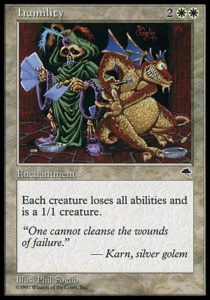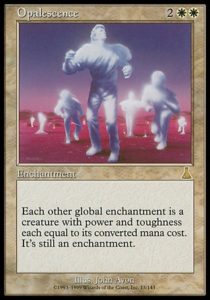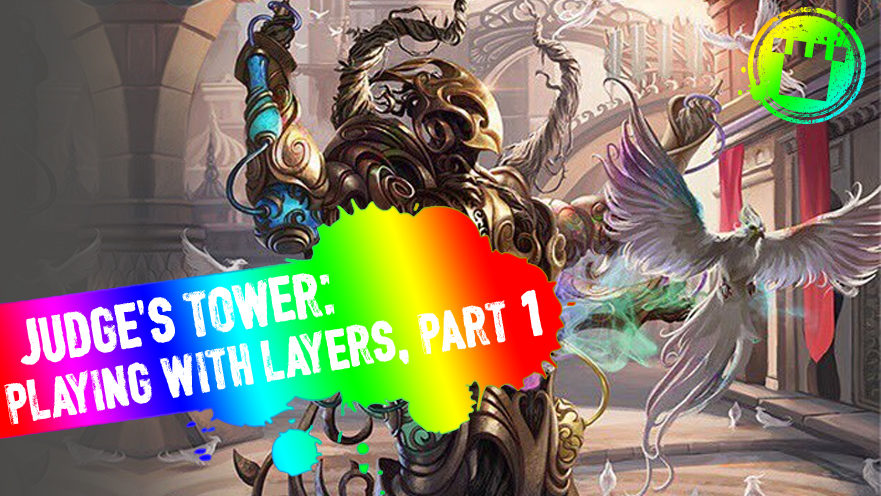Hey everyone! Today, we’re going to dive into a section of the rules that causes a lot of headaches for players and judges alike: layers! Yes, layers – a word that fills people with a cursory knowledge of the Magic rules with an undue amount of dread. There’s a lot to layers, but the concept isn’t as daunting as it might seem at first glance.
Let’s start with the classic “stump the judge” question.
SCENARIO 1
Avery and Nolan are playing a game. Avery has Humility in play and casts Opalescence. What happens?

ANSWER
Short Version: Humility is a 4/4 Creature Enchantment.
Super-Long-But-Necessary-For-Understanding-Why Version: Let’s start at the top: What do I mean by ‘layers’? I’m referring to Rule 613: The Interaction of Continuous Effects.
When two things are trying to affect the same object, it’s important to determine which effect applies to that object first, as that can change the outcome. Rule 613 sets an order for what on any given card is affected in which order by continuous effects. There are seven layers, although the last layer actually contains five sublayers. The layers, in order, are:
- Copy – For example, Clone. If Clone is on the battlefield copying something, that effect applies before anything else.
- Control – If a creature is affected by Mind Control or a similar card, this is where that effect applies.
- Text Changing – There aren’t a ton of these out there – the most recent one that springs to mind is Trait Doctoring.
- Type Changing – Blood Moon is an example that we’ve talked about before.
- Color Changing – Painter’s Servant is the poster child for this effect.
- Ability Adding/Removing – Humility is a relevant example.
- Power/Toughness Modifying – Has its own sublayers, which are:
- Characteristic-Defining-Ability – Tarmogoyf is the prime example.
- Setting to a specific number – Both Humility and Opalescence do this.
- Modifying – Giant Growth, Disfigure, etc.
- Counters – Any +1/+1 counters or the like apply here.
- Switching – Think Twisted Image.

Figuring out what happens is just a matter of starting from the top and working our way down.
When Opalescence enters the battlefield, nothing happens in Layers 1, 2, or 3. In Layer 4, Opalescence makes Humility a creature that is still also an enchantment. In Layer 6, Humility removes all abilities from all creatures.
We’re going to pause for a second here to clarify something. The question that usually comes up at this point is something like, “If all abilities are removed, then doesn’t that wipe out Humility’s own ability?” Here’s the key to any question about how layers apply: No matter what the board state, you always start as if you’re just dealing with the cards themselves with no other modifications. The layers are what apply those modifications, and since you always start from the top, you start with a blank slate.
Okay, so: Moving into Layer 7, we have a creature on the field with no native power and toughness. Two things are trying to set its power/toughness: Humility and Opalescence. There’s a specific ruling on cards like Humility:
“The type-changing effect applies at Layer 4, but the rest happens in the applicable layers. The rest of it will apply even if the permanent loses its ability before it’s finished applying.”
So now, it’s a simple question of timestamps. Humility was in play first, so in Layer 7(b), it sets its power and toughness at 1/1. Then Opalescence sets it at 4/4. If Opalescence had been in play first, then Humility would apply last and it would be a 1/1.
And there it is. The answer to the classic judge-stumper question. Not really all that tricky – it just boils down to “which thing entered last?”
Now let’s try a situation that’s a little less intuitive:
SCENARIO 2
Nolan has a Painter’s Servant in play, naming blue. Avery casts Humility. When Humility resolves, what happens?

ANSWER
When the dust settles, Painter’s Servant is a 1/1 with no abilities…but everything remains blue.
Wait, what? That can’t be right.
Yet it is! As weird as it seems, Painter’s Servant will continue to turn everything the chosen color even though it (apparently) no longer has the ability that changes everything’s color.
How does this work? Well, like above, you always start from the top down. So, both Humility and Painter’s Servant are on the battlefield. Let’s go through the layers again and see what happens.
Layers 1-4: Nothing much happens. Layer 5: Painter’s Servant changes the color of all the cards in the game to blue. Layer 6: Humility gets rid of Painter’s Servant’s ability. Layer 7: Humility sets Painter’s Servant’s power/toughness to 1/1.
So, Painter’s Servant’s effect applies before Humility wipes the ability out. It doesn’t matter that the ability isn’t there anymore – it already turned everything blue. And every time the game goes to check the layers to find out what’s happening, Painter’s Servant’s ability happens before it’s gone. It takes a bit to wrap your head around how this works – this was a huge stumbling block for me for a while. You just have to remember that whenever something new affects the board, you always start with a clean slate.
There’s still plenty more to talk about when it comes to layers. Next time, we’ll take a deeper dive into those sublayers in Layer 7. Getting the layers hammered into your head is a bit of a pain, but it ends up being more useful than you might think. Until next time, keep climbing the Tower!

Chris is the Associate Media Producer at Card Kingdom. He would like to apologize to his son for not holding onto more cards from when he first started playing, as that likely would have paid for college. He enjoys pretty much all formats of Magic, but usually ends up playing decks that make other people dislike playing those formats with him.

